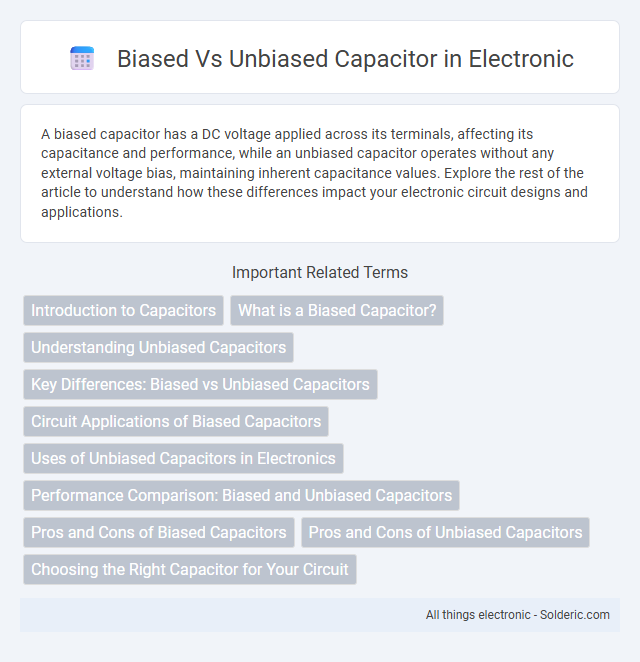A biased capacitor has a DC voltage applied across its terminals, affecting its capacitance and performance, while an unbiased capacitor operates without any external voltage bias, maintaining inherent capacitance values. Explore the rest of the article to understand how these differences impact your electronic circuit designs and applications.
Comparison Table
| Feature | Biased Capacitor | Unbiased Capacitor |
|---|---|---|
| Definition | Capacitor with an applied DC voltage bias. | Capacitor with no external DC voltage applied. |
| Application | Used in tunable filters, varactors, and voltage-controlled oscillators. | Common in general AC signal coupling and energy storage. |
| Capacitance Variation | Capacitance changes with the applied bias voltage. | Capacitance remains constant under normal AC conditions. |
| Nonlinearity | Exhibits nonlinear capacitance characteristics. | Generally linear with respect to voltage. |
| Use in Circuits | Varactor diodes act as biased capacitors for tuning. | Standard ceramic, film, and electrolytic capacitors. |
| Voltage Handling | Requires precise bias voltage control. | Rated for specific AC and DC voltages without bias control. |
Introduction to Capacitors
Capacitors store electrical energy by accumulating charge on two conductive plates separated by an insulating material called the dielectric. A biased capacitor has a DC voltage applied, affecting its capacitance and behavior in a circuit, while an unbiased capacitor operates without any external voltage. Understanding the difference helps optimize your circuit design for stability and performance in applications like filtering, coupling, or timing.
What is a Biased Capacitor?
A biased capacitor is an electronic component designed to operate under a specific DC voltage, which influences its capacitance value and performance. Unlike unbiased capacitors that function without applied DC voltage, biased capacitors offer improved stability and reduced distortion in circuits where a consistent voltage bias is essential. Your circuit's efficiency can significantly benefit from using biased capacitors in applications like RF tuning, signal filtering, and precision timing.
Understanding Unbiased Capacitors
Unbiased capacitors operate without an applied DC voltage, allowing them to store and release energy based solely on the alternating current (AC) signal. Their performance is crucial in filtering and coupling applications where signal integrity must be maintained without distortion from external bias. Understanding the behavior of unbiased capacitors helps you design circuits that require stable capacitance under varying AC conditions.
Key Differences: Biased vs Unbiased Capacitors
Biased capacitors operate with a DC voltage applied across their plates, which affects their capacitance and leakage characteristics, while unbiased capacitors function without any external DC bias, maintaining stable capacitance under varying AC signals. You should understand that biased capacitors often exhibit decreased capacitance and increased dielectric losses due to the influence of the applied voltage. This distinction is crucial for selecting capacitors in circuits where voltage bias impacts performance, such as in RF tuning or signal processing applications.
Circuit Applications of Biased Capacitors
Biased capacitors are primarily used in radio-frequency (RF) circuits, where their capacitance can be precisely adjusted by applying a DC bias voltage, enabling fine-tuning of filters, oscillators, and impedance matching networks. These capacitors are essential in varactor diode applications, where voltage-dependent capacitance allows dynamic frequency control in voltage-controlled oscillators (VCOs) and phase-locked loops (PLLs). Unlike unbiased capacitors, biased capacitors provide voltage-variable capacitance, making them indispensable in tunable circuit designs and frequency modulation systems.
Uses of Unbiased Capacitors in Electronics
Unbiased capacitors are critical in electronic circuits where stable capacitance without external voltage influence is required, such as in coupling and decoupling applications, signal filtering, and timing circuits. These capacitors provide reliable performance by maintaining consistent electrical characteristics, ensuring accurate signal transmission and noise reduction. Your electronic devices benefit from unbiased capacitors by achieving improved signal integrity and circuit stability in sensitive analog and digital systems.
Performance Comparison: Biased and Unbiased Capacitors
Biased capacitors exhibit enhanced capacitance stability and reduced equivalent series resistance (ESR) under specific voltage conditions, improving performance in high-frequency applications. Unbiased capacitors maintain consistent electrical characteristics without an applied voltage, offering reliability in circuits requiring low leakage current and minimal polarization effects. The choice between biased and unbiased capacitors directly impacts efficiency, signal integrity, and thermal stability in electronic devices.
Pros and Cons of Biased Capacitors
Biased capacitors, often used to achieve higher capacitance in a smaller physical size, offer advantages such as improved energy storage efficiency and reduced component space on printed circuit boards. However, their performance can degrade with voltage and temperature variations, leading to potential issues in circuit stability and reliability. Your choice of a biased capacitor should consider these trade-offs in capacitance boost versus potential lifetime and accuracy impacts.
Pros and Cons of Unbiased Capacitors
Unbiased capacitors offer stability with minimal leakage current and lower noise, making them ideal for precise analog signal applications where signal integrity is crucial. Their limitation lies in lower effective capacitance compared to biased capacitors, which can restrict performance in frequency-tuning or filtering circuits requiring variable capacitance. Your choice depends on balancing the need for precision against the need for adjustable capacitance in your electronics design.
Choosing the Right Capacitor for Your Circuit
Choosing the right capacitor for your circuit depends on whether you need a biased or unbiased capacitor. Biased capacitors, such as varactors, change capacitance with applied voltage, making them ideal for tuning and frequency modulation applications. Unbiased capacitors maintain a constant capacitance regardless of voltage, providing stable performance for filtering, coupling, and decoupling tasks in electronic circuits.
Biased vs unbiased capacitor Infographic

 solderic.com
solderic.com